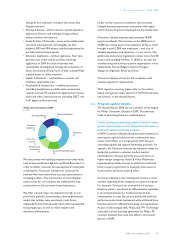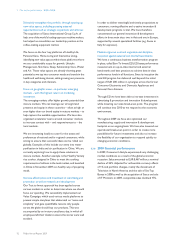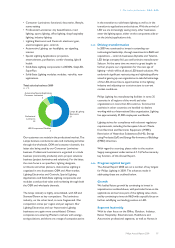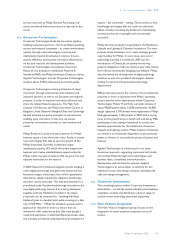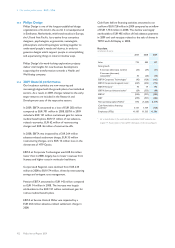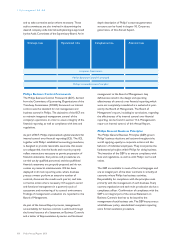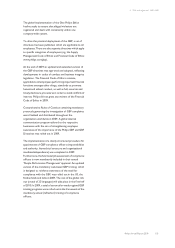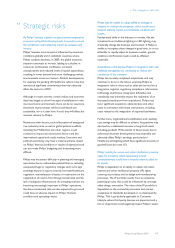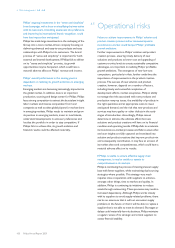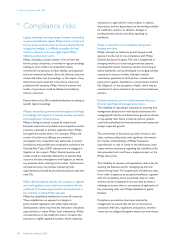Philips 2009 Annual Report Download - page 101
Download and view the complete annual report
Please find page 101 of the 2009 Philips annual report below. You can navigate through the pages in the report by either clicking on the pages listed below, or by using the keyword search tool below to find specific information within the annual report.service units such as Philips General Purchasing, real
estate and shared financial services are reported in this
sector.
5.5.2 Corporate Technologies
Corporate Technologies feeds the innovation pipeline,
enabling its business partners – the three Philips operating
sectors and external companies – to create new business
options through new technologies, venturing and
intellectual property development; improve time-to-
market efficiency; and increase innovation effectiveness
via focused research and development activities.
Corporate Technologies encompasses Corporate
Research, the Incubators, Intellectual Property &
Standards (IP&S), the Philips Innovation Campus as well as
Applied Technologies. In total, Corporate Technologies
employs about 4,100 professionals around the globe.
Corporate Technologies actively participates in ‘open
innovation’ through relationships with academic and
industrial partners, as well as via European and regional
projects, in order to improve innovation efficiency and
share the related financial exposure. The High Tech
Campus in Eindhoven, the Philips Innovation Campus in
Bangalore, India, Research Shanghai China, the Cambridge
lab and InnoHub are prime examples of environments
enabling open innovation. In this way, we ensure
proximity of innovation activities to local markets and
needs.
Philips Research is a key innovation partner for Philips’
business sectors. It has three main roles. Firstly, it creates
new technologies that help to spur the growth of the
Philips businesses. Secondly, it develops unique
intellectual property (IP), which will enable longer-term
business and creates standardization opportunities for
Philips. Lastly, it prepares ventures that can grow into new
adjacent businesses for the sectors.
In 2009, Research introduced magnetic particle imaging, a
new imaging technology that generates anatomical and
functional images of the heart, from which quantitative
information, ideally required for diagnosis and therapy
selection, can be extracted. This was demonstrated in a
pre-clinical study. Another breakthrough innovation is the
new digital pathology scanner that is being developed
together with the Healthcare Incubator. Its unique
properties can be compared to “resolving individual
blades of grass in a football pitch while scanning at a data
rate of 600 Mb/s.” Philips has adopted a people-centric
approach to research in order to ensure that our
innovations offer experiences that fully meet people’s
needs and aspirations. In dedicated ExperienceLabs, ideas
and concepts are tested using experience prototypes in a
natural – but controlled – setting. This provides us with
knowledge and insights that we could not otherwise
obtain, thereby increasing the likelihood of developing
innovations that are meaningful and commercially
successful.
Philips has three incubation organizations: the Healthcare,
Lifestyle and Lighting & Cleantech Incubators. The main
purpose of the Incubators is to create strategic growth
opportunities for Philips. In some cases, spin-out or
technology licensing is considered. 2009 saw the
introduction of DirectLife, an activity-monitoring
program designed to help you improve your daily activity
level without dramatically changing your lifestyle. Philips
also announced the development of digital pathology
solutions to ease the workload and support decision
making in central and hospital-based pathology
departments.
IP&S proactively pursues the creation of new intellectual
property in close co-operation with Philips’ operating
sectors and the other departments within Corporate
Technologies. Philips’ IP portfolio currently consists of
about 48,000 patent rights, 35,000 trademarks, 56,000
design rights and 3,100 domain name registrations. Philips
filed approximately 1,550 patents in 2009 with a strong
focus on the growth areas in health and well-being. IP&S
participates in the setting of standards to create new
business opportunities for the Healthcare, Consumer
Lifestyle and Lighting sectors. Philips believes its business
as a whole is not materially dependent on any particular
patent or license, or any particular group of patents and
licenses.
Applied Technologies is a showcase for our open
innovation approach, supporting customers both inside
and outside Philips through new technologies, new
business ideas, consultancy and new product
development and introduction services. Applied
Technologies is an active player in solutions for the
healthcare sector and energy solutions, including solar
cells and energy management.
5.5.3 Corporate Investments
The remaining business within Corporate Investments –
Assembléon – is a wholly owned subsidiary that develops,
assembles, markets and distributes a diverse range of
surface-mount technology placement equipment.
5.5.4 New Venture Integration
The New Venture Integration group focuses on the
integration of newly acquired companies across all
sectors.
5 Our sector performance 5.5.2 - 5.5.5
Philips Annual Report 2009 101


